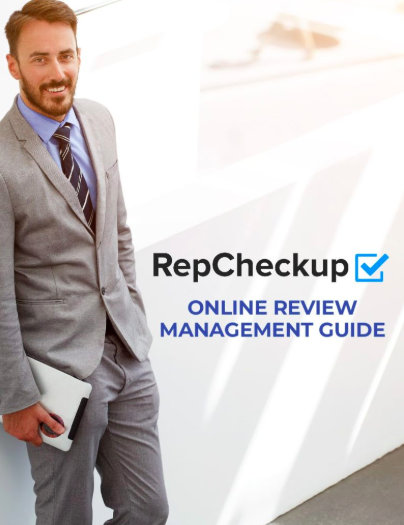
What is Reputation Management?

When properly managed, the online reputation of your business is one of your most valuable assets. Without active online reputation management, it risks becoming a liability.
At a high level, reputation management means taking control of how people perceive your business online and in real life. Your offline reality of a happy, loyal customer base may not be reflected online, especially if the loudest voice about your business online is that of a dissatisfied customer who has taken to review sites. Managing your online reputation empowers you to build a steady stream of positive online content about your business for new prospective clients to see.
Your online reputation is built based primarily on your business’s ratings and reviews, which are becoming ever-more central to consumers’ decision-making. BrightLocal’s 2016 Local Consumer Review Survey tells us that:
- 84% of people trust online reviews as much as personal recommendations
- 54% of people visit the business’s website after reading positive reviews
The second largest component of your online reputation are the social media discussions around your business. Research from Pew found that roughly 40% of U.S. adults share their thoughts about companies or products on social media.
Thus, investing in online reputation management is critical ensuring your reputation is an asset that grows the value of your business by:
- Enhancing and spreading your brand message.
- Differentiating your business from your competitors.
- Acquiring new customers and increasing the lifetime value of current customers.
- Preventing negative reviews from getting posted and mitigating the impact of any that are.
- Uncovering helpful intel and opportunities from your target market that you can use to improve customer service.
Reputation management requires proactive engagement with how people present and talk about your business online. The main elements of proactive reputation management are:
- Creating and monitoring profiles on social media and review sites
- Soliciting positive reviews
- Monitoring and engaging with reviews and social media discussions
- Analyzing and acting on what you hear in online discussions about your business to improve the overall customer experience you provide
Creating and monitoring social media and online review website profiles
As review sites and social media platforms are the main repositories of your online reputation, you must organize them to your advantage. It’s not a question of whether you should be there. Your business already is, whether it’s an unclaimed Google My Business listing or a customer’s Instagram post from your business. So it’s time to take charge and monitor the way your business is presented on social media and review sites.
Go Where Your Customers Are
There are a few steps necessary to create a great online reputation management strategy. The first step is deciding which review sites and social platforms deserve your attention. While the number of review and social media sites grows daily and you can’t be active everywhere, it’s important to engage with the sites most relevant to your business.
To make this process less time-consuming, automated reputation management tools can help you manage multiple sites at once so you don’t have to manually update each one. Even so, you still need to select which sites take priority and where you want to drive reviews. To accomplish this, you’ll want to look at where your market and competition are. This step is important because your business should have a presence on the sites your market already is using and, similarly, you don’t want to cede any online to a competitor’s dominance. You can find the long answer and more information of setting your online reputation management strategy here.
Highlight What Makes Your Business Unique
The second step is creating robust, engaging, and brand-centric profiles on your selected sites. Your profiles are the main place where you can directly define your business’s reputation. Nearly all of the content on review sites, and much of social media,is written by other people but your profiles are 100% you and a great opportunity to set the tone of your business online. Anyone reading your business’s profile should instantly understand what your offer, who you offer it to, and why they should take you up on your offer (i.e., what makes you unique).
Avoid Frustration With Accurate Information
The branding aspect of your profiles is important and should be pulled through every image and word you include. Yet some of the most crucial information on your profiles is accurate logistical information. When potential new customers can’t find your address, hours, website, and phone number quickly, they get frustrated.
So, this step focuses on making sure your profiles have complete and accurate information for customers to view. In the future, these profiles should also be immediately updated when any of business’s vital information changes.
Soliciting positive reviews
Now that you have completed creating your profiles, you need to get them filled with positive reviews. Remember, even the best businesses will have some negative reviews – don’t worry, you have several means for mitigating their impact (more on that below). In fact, the most effective way to neutralize negative reviews is to have them overwhelmed by the number of positive online reviews your business has.
The BrightLocal research found that 58% of consumers said a business’s star rating is the most important factor. Maintaining a high star rating (four stars and above) is mostly a numbers game. The more four and five star ratings you get, the easier your reputation can absorb an occasional three or even one star rating.
The best way to get a positive review (besides being awesome)? Ask for one.
Officially, some online review sites, like Yelp, prohibit actively soliciting positive reviews. Despite this, you can and should ask for reviews. What you can’t do is pay people or provide some other benefit, like a discount, in exchange for a review. Absent of that sort of quid pro quo, there’s a lot you can do, like setting up both manual and automated review request processes.
Manual review requests
There are two ways to make manual review requests – directly in person or through passive promotion. A direct ask is when a staff member directly asks a specific customer to write a review. This could be in response to a compliment (“we had a great time!”) or when someone is paying their bill. The employee doesn’t need to directly ask for a review, but could more diplomatically mention that your business has a profile on [INSERT PREFERRED REVIEW SITE HERE] where the customer could leave a review. Of course, many businesses have great success training staff to tell patrons that if they’ve enjoyed their service today to please share their experience on [INSERT PREFERRED REVIEW SITE HERE]. If a customer sends you a complimentary email, thank them via email and ask if they’d be willing to post what they wrote online. In your response, be sure to provide your review site profile link.
Whenever possible, you’ll want to let your customers know what your preferred review site is so that your reviews go where potential customers may be looking. If they end up leaving their review on a different site, that’s okay too. But if you’re working on building a bank of positive reviews on a specific site, try directing customers there.
You can also passively ask for reviews by setting up cards, signs, or stickers (where appropriate) that say your business is listed on a specific review site where customers can post a review. Many review sites, like Yelp, will provide branded collateral you can put up. You can also create your own signage and cards that include your review site link or a QR code that will instantaneously direct people right to your review site!.
Automated review requests
Automating review requests is an efficient way to maximize your efforts. You can include review requests in some email communications with customers. For example, more customers are requesting emailed receipts. If you’re set up for that, include a post-script with a link to the review site profile where you want them to leave a review.
Do you have online ordering or scheduling? When a repeat customer places an order or schedules another appointment, include the review request in the automated confirmation email that goes out. Take the same approach with text push notifications if you utilize those. Remember – keep it short.
Lastly, some review sites let you embed reviews onto your website. Including this widget with a call to action (CTA) to post a review is another request option. Even if your preferred review site doesn’t have a widget, you can include strategically placed review request CTAs with link in different places on your website and your social media profiles.
In a survey conducted by BrightLocal, it was found out that seven out of 10 consumers will leave your business a positive review if you ask. So ask away!
And whether you take the manual or automatic approach (or both). be sure to ask for the review when customer satisfaction is at its highest. Don’t let them cool off. They’ll be more willing to share their experience when you catch them when they’re most excited about your business or service.
Monitoring and engaging with reviews and social media discussions
Online review monitoring is also called “social listening” and it’s a must for effective reputation management. Running a business takes a lot of time, so you may want to make your life easier by using a monitoring tool that will let you see when you have new reviews or when someone mentions your business on a monitored social media site. “Listening-in” allows you to directly and quickly respond to a review when it makes sense.
Responding to positive reviews
One reason why people post reviews online is because they like the public nature of it. They could just tell a friend what they thought, but instead they’ve chosen to tell the world. So don’t underestimate the power of your personal response. You shouldn’t respond to every single positive review. First, hopefully you’re getting too many! Second, it will start to come off as insincere. But if someone writes a particularly specific review, you might choose to respond with a thank you and mentions one point they made (so they know you read it!). This type of positive reinforcement encourages two kinds of behavior you want more of:
- It strengthens the bond between the reviewer and your business, setting the foundation for creating a true brand ambassador for your business.
- It serves as encouragement for others to leave positive reviews.
If someone posts a positive comment on social media, thank them and include a link to your review site profile. To keep your responses fresh, let employees respond as well, especially if a review mentions them by name.
Responding to negative reviews
Handling negative reviews is a much more challenging issue. The truth is that consumers are more influenced by an extremely negative review than they are by an extremely positive one (from the Pew research). However, as with positive reviews, you needn’t respond to each one. Some people are just trolls and most people can see a troll review for what it is. You can ignore them. If a review is abusive or a flat-out falsehood, you may be able to get it removed for violating the site’s terms of service (ToS). Keep in mind that review sites really really don’t like removing reviews, so try this option judiciously.
When you do choose to respond to a negative review, it’s because they’ve either made a complaint you can respond to in general terms or have a situation you want to talk about more privately. For example, if a spa-goer complains about having to fill out forms before an appointment, you might respond by pointing out the local law requires it (if it does) or with a short explanation of why you do it and how it benefits the customer. If it’s a more personal situation, respond by asking how you can contact them privately to discuss further. This option gives you the opportunity to address a private issue privately, while publicly showing you’re responsive to your customers. If you can sort it out with the reviewer, they’ll often post a follow-up turning a negative review into a shared positive experience.
A word about social media
Social media discussions about your businesses aren’t reviews in the sense that they’re not impacting any star ratings and they have a shorter shelf life than other reviews. That’s why if someone has a positive comment, you might want to ask them to share it on a review site as well. If it’s a negative comment, take the same approach as with a negative review and try to move the conversation into the private domain. If someone has a question – answer it.
Analysis and Action
When responding to reviews and social media discussions are the micro-management of reputation management, you also want to take a macro perspective. Perhaps some of those bad reviews have a point? Maybe? Possibly? Is it worth exploring?
Yes, especially if you’re hearing variations of the same issue multiple times.
Keep track of the issues that come up in negative reviews so you can spot trends. You might discover training opportunities or processes that need improving. You might also uncover gaps in your offerings. Perhaps competitors have moved the ball forward and you’ve fallen behind.
In truth, online reviews and social media discussions are wells of information about what your market thinks, wants, and needs now, as opposed to last year or last month. It’s just wasted opportunity not to pay close attention to what they’re saying online.
Conclusion
It’s easy to think you have little influence over your online reputation, but nothing is further from the truth. The opportunities customers have to share their experiences online are the same opportunities you have to engage directly with them. With the right tools, processes and culture, you can take control of your reputation. It’s time to get serious about your online reputation management and maximize this invaluable asset.








